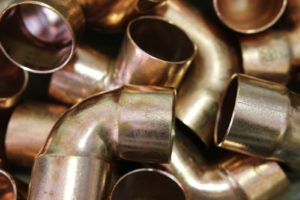 What’s a Water Hammer?
What’s a Water Hammer?
Aside from gentle whooshing, water pipes should be fairly quiet. So it’s perplexing when you suddenly hear banging. That sound is a common plumbing problem called a water hammer, and it’s caused by an increase in pressure when a faucet, valve or water appliance is shut off. The water looks for a place to go as it changes direction, and it ultimately bangs against the pipe walls or the shut-off valve in your water system, making a distinct (and alarming) pounding noise.
It’s important to address this problem promptly, as it can cause excessive wear on pipes and even leaks.
Common Causes of a Water Hammer and How to Fix It
Water in Your Air Chamber(s) = Water Hammer
The most common cause of a water hammer is an air chamber (or several air chambers) with too much water in it. Air chambers are vertical pipes that regulate pressure and prevent water from forming waves in the supply pipes. If you don’t have them, which is unlikely unless your plumbing is very old, have a professional install them at key points in your system to eliminate the waves that cause water hammers.
To reset your air chambers, turn off your main water shut-off valve, and then open all your faucets and valves. Don’t forget to open the lowest faucet you have, which could be on an outdoor hose bib or a basement sink. Opening these will drain any water suspended by pressure and allow the air chambers to clear. Turn all the faucets back off. Turn your water back on, and the water hammer should be resolved! If not, you have one of the below issues:
High Residential Water Pressure = Water Hammer
High water pressure is the cause of a water hammer, whether from faucet and appliance use or from the actual average household water pressure. If your plumbing system’s sitting pressure is too high, you may hear water hammers quite frequently, not necessarily when you use a specific faucet.
It’s easy to check the pressure yourself with a residential water pressure gauge kit from a hardware store. When you’re ready to check your pressure, turn off all appliances and faucets that use water; don’t forget sprinkler systems and refrigerators with ice makers! Then simply screw the pressure gauge onto a valve or hose bib that’s close to your main water supply source (either a municipal water meter or a well pressure tank). Open that valve slowly until it’s fully open. When the needle on the gauge stops moving, read your residential pressure. Test one more time to be sure the reading is accurate. If the pressure exceeds 80 psi, contact a plumber to install a pressure regulator or replace an existing one on the water main.
One Intense Appliance = Water Hammer
Sometimes a single appliance is responsible for pressure fluctuations that cause a water hammer. Here’s how to find the culprit appliance, which could be a washing machine, dishwasher, ice maker, sprinkler system or other: If the hammer occurs only when that appliance runs or turns off, you’ve found the culprit.
To fix the problem, install a water hammer arrester, also called an in-line water surge arrester. These can be found at most hardware stores. Choose your arrester type based on the appliance and space available. A washing machine may need a larger hose-bib-style pressure arrester on the water intake line, as a high volume of water will be flowing through. If there’s little room to install one of these, you can find a mini end-stop water hammer arrester, a 90-degree connector that threads right onto the hose connection of most appliances and fits in tighter spaces. The third type of arrester is a single-chamber arrester, which can be installed on any standard-width section of pipe, wherever needed. Hopefully, an arrester for that troublemaker appliance will resolve your pipe-pounding headache!
Wiggling Old Pipes = Water Hammer
Old water supply pipes are often not secured sufficiently to a home’s structural features, so they swing and wiggle when there’s a pressure change. Grab a flashlight, and check your crawlspace or basement’s visible supply pipes. Try to move different sections gently and see if they budge significantly in any areas. It can also be helpful to have another person run some water and turn it off to cause the water hammer; from your position, you might be able to locate the spot that’s causing the hammer! Get some pipe supports (also called pipe clips, clamps and hangers) and/or some plumber’s tape, and secure the pipes more soundly. If you have copper pipes, don’t use galvanized or steel supports or straps, as the metals could react poorly together (electrolysis) and cause a leak. Plastic clips and plumber’s tape are safest and are easy to use.

Recent Comments